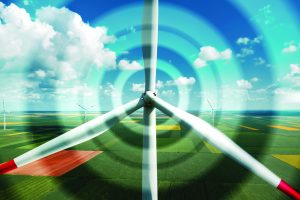The cost of maintenance in the wind-turbine industry is escalating: A report from GlobalData estimates that the cost of turbine maintenance will rise to about $17 billion in 2020 — nearly twice that of 2014. It’s because the number of turbines is increasing — including many old ones that require more frequent maintenance. For an offshore wind farm, about one-quarter of total cost is accounted for by operation and maintenance.
Introducing sophisticated condition monitoring technology can help keep these costs under control. Employing vibration monitoring to keep tabs on a turbine’s rotating parts helps maintenance teams to spot potential problems and carry out necessary repairs at the earliest opportunity in order to avoid breakdowns. In this technique, the vibration “signature” of bearings and other moving parts is monitored using vibration sensors (otherwise known as “accelerometers”). Any variation from the norm can indicate early signs of failure, allowing small problems to be corrected before they spiral out of control.
Wind power is a booming area of engineering. In 2017, global capacity for wind turbines hit 539,581, according to the Global Wind Energy Council. Not surprisingly, this figure is expected to grow significantly over the next decade — some outlets suggest global capacity may be four times higher by 2030.

Let’s not forget, however, that wind power is also highly demanding. To achieve profit, operators must run as efficiently as possible by raising output and controlling costs. Preventing unscheduled downtime — such as through catastrophic part failure — is key to this. However, wind turbines must perform under punishing conditions: There have been instances in recent years of high winds causing turbines to explode through gear failure. As well as footing the repair bill, operators may also be faced with fines and compensation costs.
While the sensors used in high-spec applications like wind turbines are top of the range, their price has come down far enough to justify the use of multiple sensors, which enhances data gathering. Using multiple sensors also helps to boost techniques such as acceleration enveloping (more on this later), which “extracts” the vibration signal of a failing bearing by filtering out the “noise” of other components.
Downtime Costs
Unscheduled downtime does not just affect the wind-turbine industry: According to a recent joint survey from plantservices.com and ARC advisory group, the problem costs global process industries about $20 billion every year. The goal for nearly 90 percent of all companies using predictive maintenance was to increase uptime, said the survey. In addition, more than half wanted to use predictive maintenance techniques and processes to cut maintenance and overall operational costs.
Among its conclusions, the survey recommended that predictive maintenance should ideally be integrated with plant-wide control systems, and that the operation and outcomes of such systems should be linked to financial incentives for plant operators. It makes a strong case for fitting such systems, especially in an industry such as wind energy where maintenance is difficult and costly, and operators are under pressure to maximize efficiency and productivity.
While this type of maintenance regime has its obvious advantages, there are historical factors to overcome: Many engineers have genuinely considered it cheaper to continue running with worn equipment rather than invest in “costly” replacements. However, when the costs of unscheduled downtime are considered, this “efficiency” theory is proved to be nothing more than myth.
Machines that have begun to exhibit defects are at greater risk of failure than those without defects, so they are more likely to generate unwelcome downtime costs. In contrast, a condition-monitoring system helps engineers plan maintenance and replace defective components before problems occur.
Sensor Installation
When mounted in key positions on mechanical equipment, vibration sensors offer continuous monitoring and analysis. While this requires investment, it is minimal when compared with the potential cost of downtime on a wind turbine.
There are two main types of industrial accelerometers: AC accelerometers and 4-20mA accelerometers. AC accelerometers are typically used with data collectors for the vibration monitoring of more critical or complex machines, such as gearboxes and turbines, so are the sensor of choice for wind turbines. In general, 4-20mA sensors are used with PLCs to measure lower value assets such as pumps and motors.

The latest vibration monitoring sensors operate over a wide temperature range, measuring both high and low frequencies with low hysteresis characteristics and high levels of accuracy. Because of the punishing conditions they must withstand, they offer robust and reliable service thanks to stainless steel sensor housings to prevent the ingress of moisture, dust, oils, and other contaminants.
Accelerometers can be mounted on casings to measure the vibrations of the casing and/or the radial and axial vibration of rotating shafts. A typical approach is to examine the individual frequencies in a signal that correspond to certain mechanical components or types of malfunction – such as shaft imbalance or misalignment, so analysis of this data can identify the location and nature of a given problem. A typical example would be a rolling-element bearing that exhibits increasing vibration signals at specific frequencies as wear increases.
Vibration Specification
To specify a vibration accelerometer correctly, engineers must consider the vibration level and frequency range to be measured, weight or fitting restrictions, and environmental conditions. It’s best to work closely with a supplier that has appropriate industry experience and knowledge.
For wind-turbine applications, low-frequency accelerometers are the ideal choice for detecting anomalies. In general, the models used on wind turbines are 100mV/g, or the higher sensitivity 250 or even 500mV/g. These might be used to monitor the low-speed aspects of the generator such as output shafts.

In most of the wind-turbine projects Hansford Sensors has been involved in, a local junction box was used to house the accelerometer cabling at the top of the turbine. This is usually fed back down to the ground using multi-core screened twisted pair cable to connect it to an online monitoring system, allowing operators to monitor turbine conditions in real time using a handheld device with internet access. Such a system will identify faults and enable maintenance engineers to take corrective action prior to failure.
Accelerated Results
While the latest accelerometers are highly sophisticated, in some instances it can be a challenge to find a signal — such as that of a malfunctioning bearing — among all the other vibrations generated by a turbine.
An effective way to do it is to use acceleration enveloping: a signal processing technique that filters out low-level, repetitive vibrations to leave a “clean” signal that indicates the sound of a bearing alone. It is used in many applications to separate the signal of a malfunctioning bearing from the noise from the rest of a machine. It enables engineers to overcome the limitations of conventional velocity spectrum measurements and detect component failures at the earliest possible stage. The rate of wear then can be monitored and maintenance work planned accordingly.
A defect in a rolling element will cause repeated impacts that generate resonant frequencies in the surrounding machine surfaces, causing a “ringing” signal. Although the amplitude of the signal decays between impacts and becomes part of the overall vibration signal of the machine, it will affect the natural resonance response of the machine at the impact frequencies.
The signal from an accelerometer can be enhanced with acceleration enveloping. It progressively filters out unwanted parts of the vibration spectrum until the signal of the bearing defect can be isolated from the noise around it and clearly be identified.
Low and High
The unfiltered waveform from a failing bearing is a mixture of low and high frequencies with no obvious pattern. Acceleration enveloping uses a two-step process to overcome this. The first step is to apply a band pass filter, which isolates only those frequencies in which the signal of interest is hiding. The filtered output pinpoints repeating, high frequency signals, caused by impacts of the rolling elements hitting the defect of the rotating bearing. These signals are represented graphically by a series of energy “spikes.”

In the second step, the filtered output is passed through an envelope. Here, the waveform is rectified — that is, the negative part is inverted to positive. This is then demodulated by tracing a line over the general shape of the rectified signal. This “envelope” is now used as a true vibration signal, helping it stand out from the noise.
The envelope helps to contain regularly spaced signals, such as a single defect on a raceway. Other causes of noise, such as shaft rub, are random, so they will not produce evenly spaced peaks. Once the signal has been filtered, the information is taken from the accelerometer using a data collector. A specialist can then review and interpret the data and decide whether maintenance is required immediately or can be done as part of routine schedules.
Conclusion
Wind-turbine operators are under constant pressure to run operations as efficiently as possible by raising output and controlling costs.
A predictive maintenance regime based on vibration monitoring can reduce catastrophic breakdowns, boost turbine availability, and increase the economic viability of wind energy. Coupling this with acceleration enveloping can further enhance efficiency.
This kind of maintenance regime is especially effective for offshore wind turbines, which are more expensive to repair due to their remoteness. Together, these techniques can help to cut the cost of maintenance and begin chipping away at the wind-power sector’s potential $17 billion maintenance bill by 2020.
































